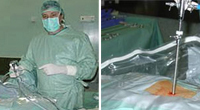

 FACULTATIVO ESPECIALISTA CIR. ORTOPÉDICA Y TRAUMATOLOGÍATraumatología y Cirugía OrtopédicaCentro Médico Teknonen/health-centers/centro-medico-teknon
FACULTATIVO ESPECIALISTA CIR. ORTOPÉDICA Y TRAUMATOLOGÍATraumatología y Cirugía OrtopédicaCentro Médico Teknonen/health-centers/centro-medico-teknon

In present time, surgery is evolving towards a minimal aggression on the patient.
Classical spine surgery usually performed wide incisions in order to allow a clear visualization of the tissues to be operated on, to control bleeding (hemosthasis) and to create the necessary space for the instruments of that particular period of time.
 Nowadays, thanks to technological evolution, a patient can be operated through a minimal skin incision, visualizing all structures and tissues through an optical fibre on a TV monitor, avoiding bleeding problems and using highly evolved instruments.
Nowadays, thanks to technological evolution, a patient can be operated through a minimal skin incision, visualizing all structures and tissues through an optical fibre on a TV monitor, avoiding bleeding problems and using highly evolved instruments.
This type of surgery is called "Minimal Invasive Surgery" (MIS) and it was initiated in the 70ies with arthroscopies (knees, shoulders, etc.) and in the 80ies with endoscopies (abdominals, urogenitary, etc.). Finally, this kind of surgery has also reached the area related to the spine, resulting in endoscopic spine surgery
 As it is not necessary to open up (discect) the tissues, aggression on them is minimized. Thus the patient recovers much more rapidly, allowing a much earlier reinsertion into their work.
As it is not necessary to open up (discect) the tissues, aggression on them is minimized. Thus the patient recovers much more rapidly, allowing a much earlier reinsertion into their work.
This type of endoscopic surgery is performed under local anaesthesia and allows the patient to get back home before 24 hours after the operation.
 Medication and post-surgical ingestion of medications is minimized or may even be completely unnecessary in most of the cases.
Medication and post-surgical ingestion of medications is minimized or may even be completely unnecessary in most of the cases.
The patient will be able to live a normal life up to 24 hours after the intervention and will be able to start rehabilitation aprox. 15 days after the operation.
 This new procedure requires, because of the necessary minimization of the instruments, new and advanced technologies like LASER, radiofrequency and other sophisticated techniques, that allow to eliminate and to remodel the disc alterations in the lumbar spine. x of minimal invasive surgery allows an effective treatment against lumbar pain, sciatica and sciatic pain. It is indicated for many cases in which less or nothing could be done from a surgical point of view, with classical procedures because of not presenting clear enough neurological compromises.
This new procedure requires, because of the necessary minimization of the instruments, new and advanced technologies like LASER, radiofrequency and other sophisticated techniques, that allow to eliminate and to remodel the disc alterations in the lumbar spine. x of minimal invasive surgery allows an effective treatment against lumbar pain, sciatica and sciatic pain. It is indicated for many cases in which less or nothing could be done from a surgical point of view, with classical procedures because of not presenting clear enough neurological compromises.
 The new concept is all about treating the inflamated disc that is generating the pain, before it continues degenerating.
The new concept is all about treating the inflamated disc that is generating the pain, before it continues degenerating.
The future of spine endoscopy is to become an everyday procedure, as it has happened with knee arthroscopies. Nobody operates anymore a ruptered meniscus by the classical, open way (knee arthrotomy) without trying first an arthroscopy.
 With these minimal invasive techniques, a hernia with or without neurological pain, to a foraminal stenosis or a simple protusion causing annoyances to the patient, can be effectively operated with low risk and a high quality of life for the patient.
With these minimal invasive techniques, a hernia with or without neurological pain, to a foraminal stenosis or a simple protusion causing annoyances to the patient, can be effectively operated with low risk and a high quality of life for the patient.


- ¿Qué tratamientos permite la cirugía endoscópica de columna?
- Hernia discal
- Protusión discal
- Pinzamiento discal
- Estenosis foraminal
- Canal estrecho
- Lumbalgia
- Lumbociatalgia
- Otras patologías
- ¿Cómo se realiza la cirugía endoscópica de columna?
- Bajo anestesia local
- Con incisiones de sólo 5 mm
- Es mucho menos agresiva que la cirugía abierta de columna (también llamada microcirugía o microdiscectomía)
- El dolor suele comenzar a remitir a las 12 horas de la intervención
- Permite al paciente regresar a su domicilio antes de 24 horas tras la operación
- Vídeo

Haga click en la imagen para visualizar el vídeo



































